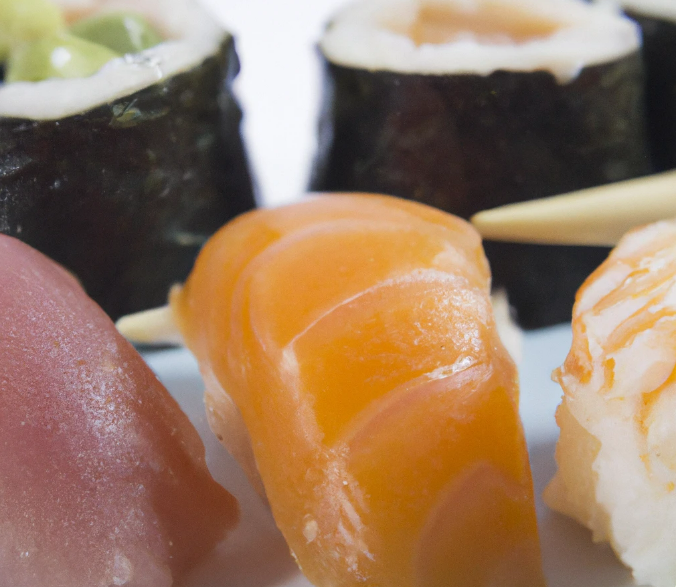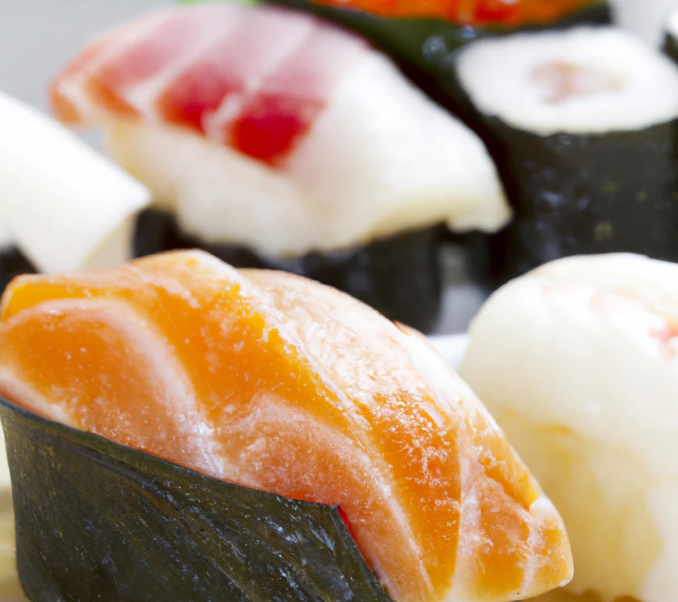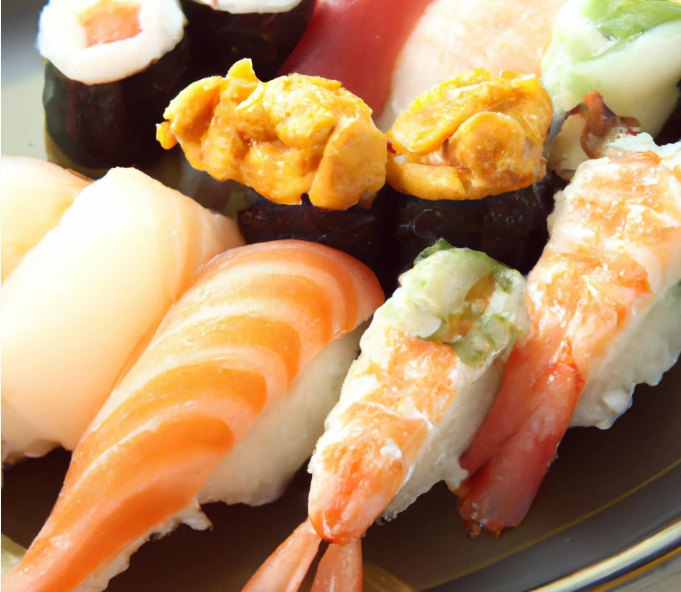If you want to make homemade sushi, you may be wondering what the difference is between regular rice and sushi rice. You could also wonder if regular rice is suitable for a Japanese – style sushi recipe.
Unlike traditional white rice, Sushi rice features uniquely shorter grain rice and has a distinct texture, particularly its sticky consistency. As such, this provides the best taste for sushi. Sushi rice is primarily used for preparing sushi, whereas white rice is utilized for all other cooking purposes.
This detailed article will look at everything you need to know about cooking sushi rice. Keep scrolling to learn more about the primary differences between sushi rice and plain white rice. We will also answer different questions about why sushi rice is preferable to white rice in sushi preparation.
Table of Contents
Can You Use Regular Rice for Sushi?
Before delving any deeper, it is vital to the basics, like, ‘What is Sushi Rice?’ and ‘what is white rice.’ Generally, sushi rice is a type of Japanese short rice grain that is more transparent and sticky than regular rice. Since it is steamed, the individual rice grains become fluffy and cling together to give it a unique texture and flavor.
Compared to ordinary white rice, sushi rice has a great balance of isolated and sticky grains. Likewise, locally known as uruchimai, rice is the standard Japanese rice that everyone consumes. Therefore, most home cooks living in Japan use it for almost everything. Sushi rice is available in any Asian or Japanese grocery store, or you can make it yourself at home.
On the other hand, the most widely used rice is white, available at every grocery store and supermarket. Regular rice comes in three significant options based on grain size: long-grain, medium-grain, and short-grain. Sushi rice is best made with short-grain rice.
If short-grain rice is unavailable, it is possible to use medium-grain rice types to make sushi. By all means, avoid using long-grain rice. Besides sushi, long-grain rice is ideal for practically all traditional Japanese recipes. This is because of its lack of starch that prevents it from being sticky enough.
Most white rice strains, such as Basmati Rice, Jasmine rice, American White Rice, Mexican rice, and European white rice, are long-grain rice. These strains come in a variety of textures and flavors. European white rice, for instance, is not sticky and hence is not ideal for making sushi.
However, it is possible to make sushi using regular white rice. When you wash this rice type for a few minutes, you can make it stickier. Washing it too much can get rid of eliminating all the starch. You may also opt to soak it in some water before cooking it. Keep in mind that it becomes stickier when you use more water for cooking it. But, it will not have the same flavor as sushi rice. As a result, sushi rice is still the ideal option for your sushi.
Can You Use Regular Vinegar for Sushi?
Sushi vinegar is used to make the vinegar rice used in sushi rolls. It is traditionally produced by combining salt, sugar, and rice vinegar. It may also include kelp (dashi stock of Kombu). In Japan, several companies have developed powdered or liquid sushi vinegar, which will make your sushi roll preparation much more straightforward.
Even though sushi vinegar is mainly used for creating sushi, it may also be used to make salads and pickled dishes. If you have sushi vinegar on hand, making vinegar rice is quite simple. But what if you do not have any rice vinegar? It serves an essential purpose, but many substitutes are available on the market. Regular vinegar is one of them.
Try regular white vinegar, apple cider vinegar, or champagne vinegar to prepare sushi rice if you do not have rice vinegar. Other viable options include lemon juice and white wine, but they are not as popular. Boil salt, sugar, and vegetable oil, then stir it into the cooked sushi rice. Proceed to mix it until it is completely dry before making the sushi rolls.
Can You Use Thai Sticky Rice for Sushi?

Sticky rice and sushi rice are distinct rice grains with different aromas and textures. Sushi rice is Japanese short-grain rice that, when correctly prepared, develops a sticky consistency and is used for sashimi rolls and sushi recipes. Sticky rice has a circular rice grain that becomes exceedingly sticky after cooking it. It is commonly used in sweets and hails from Thailand.
It is also not ideal to use jasmine or basmati to make sushi rice because it is not sticky enough. If you choose to use this type of rice, you will notice that it does not get fluffy enough and fall apart quite easily. As such, if you are looking for the best rice grain for cooking sushi rolls, always opt for short-grain rice.
Sushi Rice vs. Sticky Rice
When differentiating between sushi rice and sticky rice, many people are often confused by these two terms. Whereas many Southeast Asians are familiar with the phrases, someone who has not grown up eating this long grain sticky rice is often perplexed as to what type of rice grain it is. What does it imply when it indicates “sticky”? Trying to label it “glutinous rice” does not help provide differences. After all, a problem is not solved by giving it a new name.
In contrast to its long grain substitute, every short-grain rice is sticky. This is because starch concentration varies from rice grain to the next. Stickiness is proportional to the amount of starch in the mixture. (Even when it comes to the same form of rice, the starch content varies.) As a general rule of thumb, a new crop has more starch content than an older crop.
Many people refer to sushi rice as sticky rice as well. This term is used to describe the types of rice used in Korean cuisine. If you are perplexed, it is entirely understandable. If you are pressed for time, skim over the article on Wikihow on Thai-Laotian customs that clearly defines the kinds of sticky rice used to make various Korean cuisines.
According to Serious Eats, there are two significant rice subspecies grains globally. One is japonica, whose grains are tubby, short, and sticky. The other is indica, whose grains are thin, long, and dry upon cooking it. Most rice has two starches; amylopectin and amylase. The absence or presence of these two starches dictates the rice grain’s stickiness once you cook it. Rice that contains more amylose becomes fluffy upon cooking it; hence, it is less sticky. Below are some critical differences between sushi rice and sticky rice.
Sticky rice can be used to make various sweets and savories.
Sticky rice, also called sweet rice or gelatinous rice, comes from East and Southeast Asia and regions like Laos and Northern Thailand. Since it only needs minimum water maintenance, this rice form can survive in upland and lowland regions. Keep in mind that this kind of rice gets its sticky texture from hitting high levels of amylopectin. In turn, it is an excellent source of antioxidants due to its high mineral and vitamin content.
Thanks to its versatile nature, many people use sticky rice to make desserts like mango and sticky rice, Japanese mocha, and Chinese dumplings. It can also be utilized to make savory dishes like roast duck stuffing. It is always advisable to eat this rice within 24 hours of cooking it when it comes to storage. If you choose to store it in the fridge, take note that it will only last for a maximum of two days.
If you opt to freeze it, you should exercise care in wrapping it as such rice is likely to experience freezing burn. This issue results from storing sticky rice in a ziplock container without securing the packaging properly. In turn, this leads to the sweet rice not entirely freezing, leading to damage by oxidation and dehydration.
Sushi rice is a staple food among many Asian households.
The sushi rice, sometimes called Calrose rice, is used in America to make Temaki, Nigiri, Temaki (hand rolls), California rolls, chirashi rolls, spicy tuna rolls, and other sushi rolls. This variety of rice has a higher moisture content, which makes it sticky, perfect for preparing sushi rolls.
While various rice can be used to make sushi recipes, Japanese short-grain rice is ideal for creating rolls. The two most popular Japanese short-grain rice used to make sushi recipes are Akitakomachi and Koshihikari rice. Koshihikari rice, locally known as Koshi rice, is the most prevalent type used in Japan as it has healthy rice grains, a sticky texture, and a sweet aroma.
The ideal sushi rice is sour, sweet, and salty without overpowering the tastes of other ingredients. In addition, sushi rice has more amylose than sticky rice. So, although it is still sticky, it is also quite soft, even after it cools.
Since sushi rice comes from combining short-grain rice with a vinegar mixture, it is best to consume it immediately after making it. If you choose to use it the next day, you will likely not get the same flavor or consistency. After preparing sushi rolls, please place them in an airtight container and seal them with plastic wrap before placing them in the refrigerator. Do this an hour or an hour and a half from the time of making them.
How to make sushi rice with regular rice!
Generally, you can make sushi at home without spending $20 or even more at sushi restaurants. In the section below, we will look at in-depth details on various techniques of making sushi rice with regular rice. If you are looking for short articles on how to do this, you can skim through Wikihow.
Technique 1: How to make regular rice stickier?
1. Do not rinse out the regular white rice as it removes the starch content that causes it to clump up together.
2. Soak the rice in water for approximately 30 minutes to four hours before cooking it. Proceed to drain the water after you have finished soaking it.
3. Use more water than you need to make the rice stickier. In turn, fill up your pot with 450 millimeters of tap water and a few extra tablespoons. You could add a pinch of table salt to the water to add to the flavor of the rice.
4. Add one cup (200g) of long-grain or medium-grain rice and 1.5 cups (300g) of short-grain rice. Both basmati and jasmine types of rice are known as medium grain rice.
5. Allow the mixture to boil over high heat. Do not cover up the pot with a lid.
6. Once the water starts boiling, reduce the heat and allow the rice to simmer for about ten minutes.
7. Turn off the heat when the water finishes and leave the pot covered for approximately ten minutes. The longer you allow the rice to sit, the stickier it becomes.
Once the rice absorbs all the water, you could also mix four tablespoons of rice vinegar, a teaspoon of salt, and two teaspoons of sugar in a saucepan and mix them all. This vinegar mixture might make your rice stickier and also act as its seasoning.
Boil the mixture over medium heat and stir it until the sugar dissolves. Combine the seasoning and the rice bit by bit in a separate clean bowl when everything is cool. You can mix it all using a spatula, but not made from metal, as the seasoning may acquire the metal taste.
You could also make sushi rice from regular rice using a rice cooker for sushi rice, Instant Pot, or stovetop. The steps mentioned above are steps to follow when using a stovetop. When using an Instant Pot or pressure cooker, cook on low pressure for about 12 minutes and then allow the Instant Pot to release the pressure naturally. If you are using a rice cooker, put water and rinsed rice into the oven and turn on the white rice setting to allow it to cook.
Summary
Now that you know everything you need to know about sushi rice, including making it using normal rice, you are well on your way. However, always remember that the best rice to make sushi is sushi rice. Although you can use standard plain rice and sticky rice to create several dishes, they are not suitable alternatives for making sushi. Sushi rice has an ideal balance of sour, sweet, and salty flavors.


